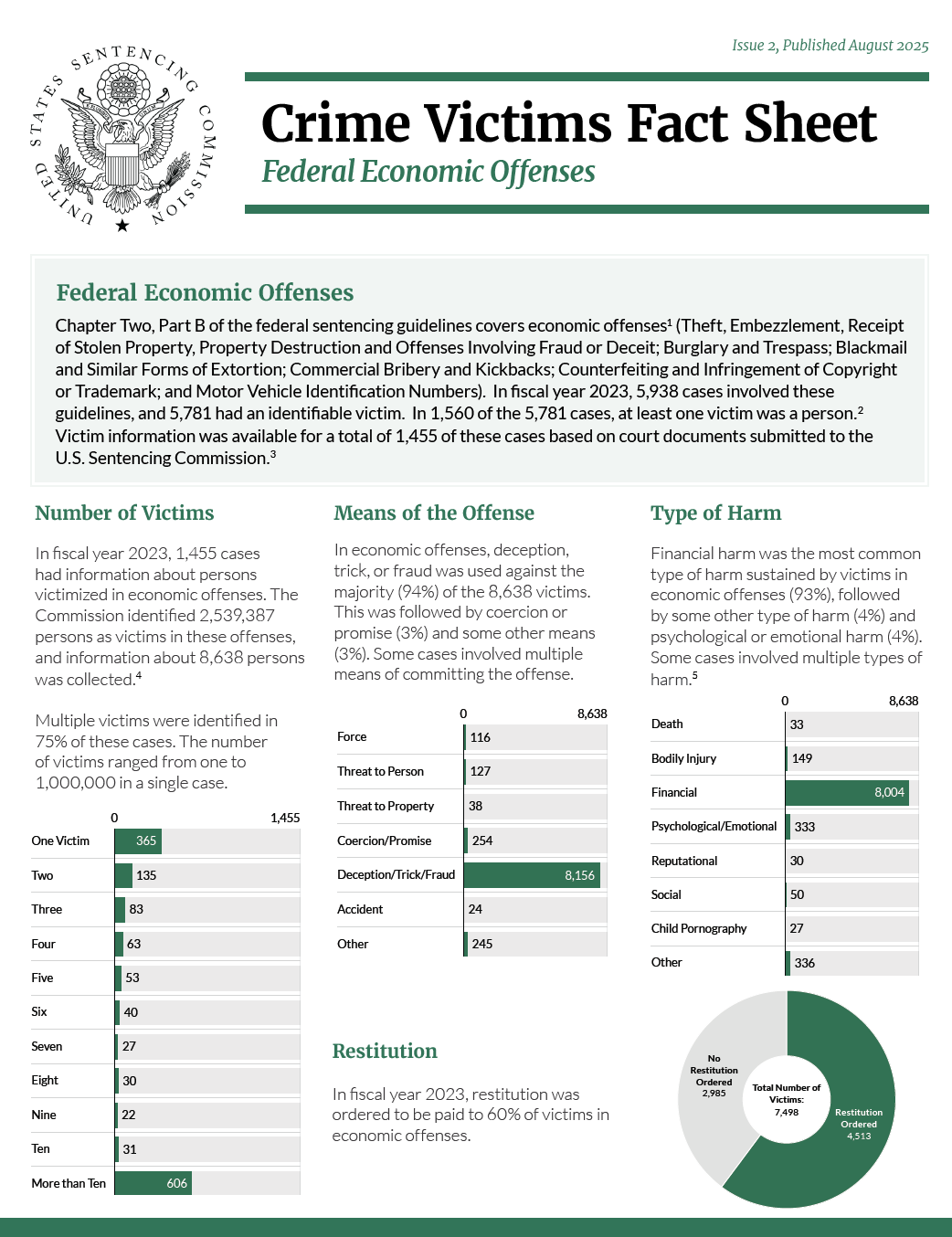CRIME VICTIMS FACT SHEET
Federal Economic Offenses
Chapter Two, Part B of the federal sentencing guidelines covers economic offenses1 (Theft, Embezzlement, Receipt of Stolen Property, Property Destruction and Offenses Involving Fraud or Deceit; Burglary and Trespass; Blackmail and Similar Forms of Extortion; Commercial Bribery and Kickbacks; Counterfeiting and Infringement of Copyright or Trademark; and Motor Vehicle Identification Numbers).
In fiscal year 2023, 5,938 cases involved these guidelines, and 5,781 had an identifiable victim. In 1,560 of the 5,781 cases, at least one victim was a person.2 Victim information was available for a total of 1,455 of these cases based on court documents submitted to the U.S. Sentencing Commission.3
Click the button for a PDF or learn more below.
NUMBER OF VICTIMS
In fiscal year 2023, 1,455 cases had information about persons victimized in economic offenses. The Commission identified 2,539,387 persons as victims in these offenses, and information about 8,638 persons was collected.4
Multiple victims were identified in 75% of these cases. The number of victims ranged from one to 1,000,000 in a single case.
MEANS OF THE OFFENSE
In economic offenses, deception, trick, or fraud was used against the majority (94%) of the 8,638 victims. This was followed by coercion or promise (3%) and some other means (3%). Some cases involved multiple means of committing the offense.
TYPE OF HARM
Financial harm was the most common type of harm sustained by victims in economic offenses (93%), followed by some other type of harm (4%) and psychological or emotional harm (4%). Some cases involved multiple types of harm.5
RESTITUTION
In fiscal year 2023, restitution was ordered to be paid to 60% of victims in economic offenses.
RELATIONSHIP BETWEEN VICTIMS AND INDIVIDUALS WHO CAUSED HARM
In economic offenses, the most common association between victims and the individuals who caused them harm was as a stranger (58%). The next most common was as a customer or client (29%). Some cases involved multiple relationship types.
66% of victims in economic offenses were harmed by more than one individual.
VULNERABILITY
Some economic offenses involved victims who were unusually vulnerable due to age, physical or mental condition, or other factors.6 The Commission identified 17% of victims in these cases as unusually vulnerable for one of these reasons. Some cases involved multiple vulnerabilities.
VICTIM CHARACTERISTICS
Less than 3% of victims in economic offenses were juveniles.
Almost half (47%) of victims in economic offenses were female.
ENDNOTES
1 Federal Economic Offenses include individuals sentenced in fiscal year 2023 in cases involving USSG §§2B1.1. (Larceny, Embezzlement, and Other Forms of Theft; Offenses Involving Stolen Property; Property Damage or Destruction; Fraud and Deceit; Forgery; Offenses Involving Altered or Counterfeit Instruments Other than Counterfeit Bearer Obligation of the United States); 2B1.4. (Insider Trading); 2B1.5. (Theft of, Damage to, or Destruction of, Cultural Heritage Resources or Paleontological Resources; Unlawful Sale, Purchase, Exchange, Transportation or Receipt of Cultural Heritage Resources or Paleontological Resources); 2B2.1. (Burglary of a Residence or a Structure Other than a Residence); 2B2.3. (Trespass); 2B3.3. (Blackmail and Similar Forms of Extortion) 2B4.1. (Bribery in Procurement of Bank Loan and Other Commercial Bribery); 2B5.1. (Offenses Involving Counterfeit Bearer Obligations of the United States); 2B5.3. (Criminal Infringement of Copyright or Trademark), and 2B6.1. (Altering or Removing Motor Vehicle Identification Numbers, or Trafficking in Motor Vehicles or Parts with Altered or Obliterated Identification Numbers); or a conviction under 18 U.S.C. § 1028A. This excludes §§2B3.1. (Robbery) and 2B3.2. (Extortion by Force or Threat of Injury or Serious Damage) cases, which have been included in the Federal Offenses Involving Force or Threat Against the Person Crime Victims Fact Sheet.
2 An identifiable victim can be a person, business, government, or other type. This series provides victim information on persons.
3 The Commission’s Crime Victims Fact Sheets series relies on information collected and analyzed through a special coding project undertaken by the Commission to gather information beyond what is regularly collected and reported on by the Commission.
4 The sentencing documents received from the courts by the Commission are often focused on the sentencing event; therefore, some information regarding the victims of the offense was not provided in the documents available for staff review. For this reason, the total number of cases with complete information, and the corresponding number of victims in those cases, will vary by analysis. Victim information was collected for the first ten persons documented in the records.
5 In a small number of cases, the type of harm resulted from additional counts of conviction for offenses other than the ones discussed in this fact sheet. All of the harm types involved in a case are reported in this fact sheet.
6 In some, but not all, of these cases the court applied the adjustment at USSG §3A1.1. Vulnerability due to advanced age or youthfulness was determined by the offense conduct stated in the presentence investigation report adopted by the court, and not based on any minimum or maximum age.
SOURCE: U.S Sentencing Commission, 2023 Victim Datafile, VICFY23.

